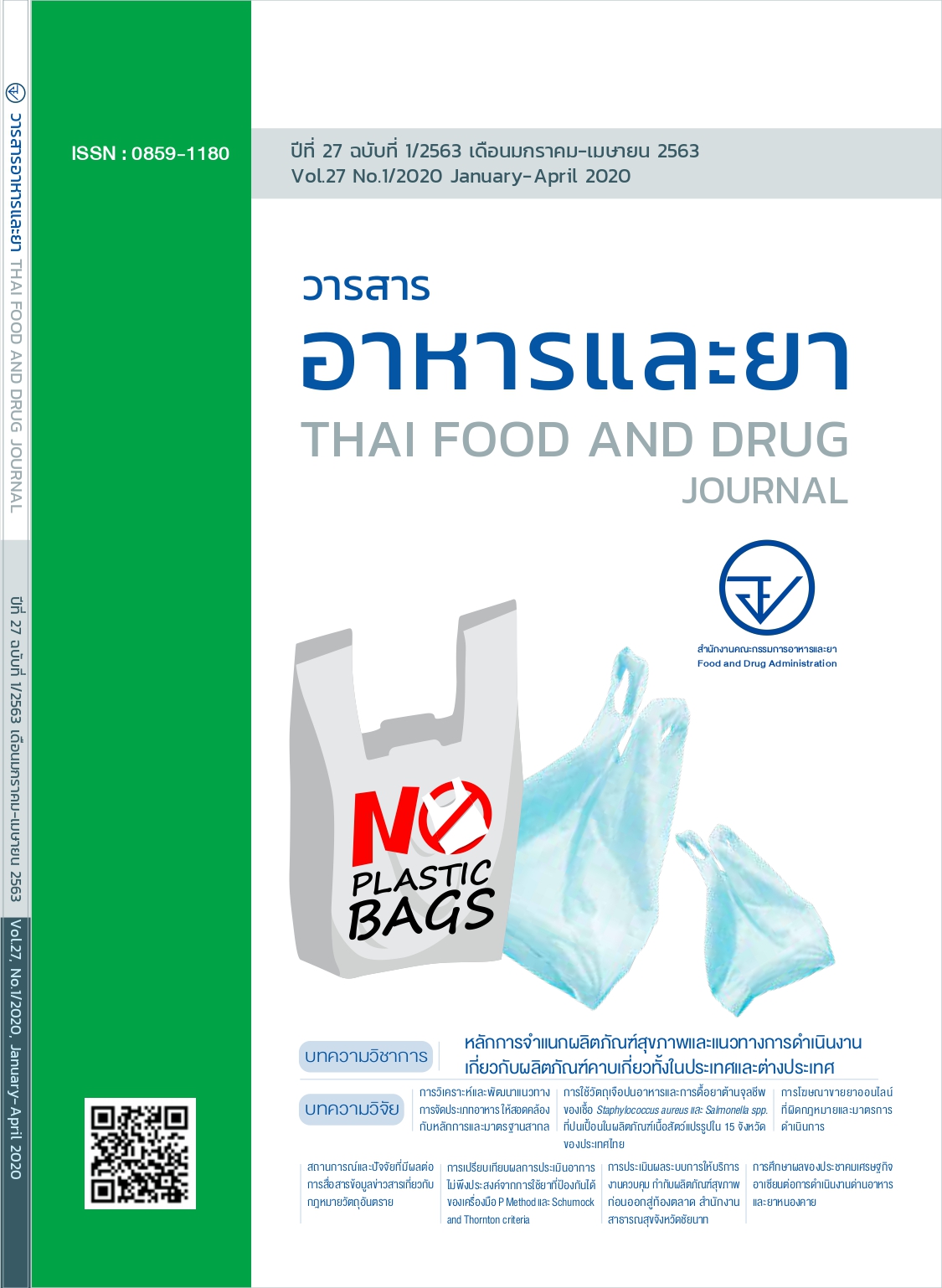การโฆษณาขายยาออนไลน์ที่ผิดกฎหมายและมาตรการดำเนินการ
Main Article Content
บทคัดย่อ
จากข่าวผู้บริโภคที่ได้รับอันตรายจากการใช้ยาปรากฏว่ามักเกิดจากอิทธิพลของการโฆษณาออนไลน์
ซึ่งสามารถสั่งซื้อยาได้ง่าย การศึกษาวิจัยนี้มีวัตถุประสงค์เพื่อศึกษาสถานการณ์ปัญหาการโฆษณาขายยาออนไลน์
ที่ผิดกฎหมายเพื่อเสนอมาตรการแนวทางดำเนินการแก้ไขปัญหาเพิ่มเติม โดยเน้นที่ผู้มีส่วนได้ส่วนเสีย วิธีการ
เป็นการวิจัยเชิงพรรณนา โดยการเก็บข้อมูลการโฆษณาขายยาทางสื่อออนไลน์แบบบังเอิญจำนวน 500 ตัวอย่าง
ระหว่างวันที่ 15-22 พ.ย. 2562 ครอบคลุมทั้ง 7 วันของสัปดาห์ จากเว็บไซต์หลัก (บริษัทเจ้าของยาเป็นผู้จัดทำ)
เว็บไซต์ทั่วไป (ได้แก่ เว็บไซต์เกี่ยวกับสุขภาพและเว็บไซต์ราชการ) เว็บไซต์ e-marketplace และเว็บไซต์ social
media ร้านค้าออนไลน์/ร้านขายยาออนไลน์ และวิเคราะห์ข้อมูลเชิงเนื้อหา ได้แก่ รูปแบบและเนื้อหาการโฆษณา
ในด้านกฎหมาย ผลการวิจัย จากการเก็บข้อมูลการโฆษณาขายยาทางสื่อออนไลน์ทั้งหมด 500 ตัวอย่าง จัดเป็น
การโฆษณาขายยา 451 รายการ (ร้อยละ 90.2) และเป็นการโฆษณาที่อวดอ้างสรรพคุณเป็นยา 49 รายการ
(ร้อยละ 9.8) โดยจำแนกตามเลขสารบบหรือเลขจดแจ้งตามกฎหมายเฉพาะ ได้แก่ อาหาร 3 รายการ (ร้อยละ 0.6)
เครื่องมือแพทย์ 12 รายการ (ร้อยละ 2.4) เครื่องสำอาง 16 รายการ (ร้อยละ 3.2) ผลิตภัณฑ์สมุนไพร 7 รายการ
(ร้อยละ 1.4) และเป็นการโฆษณาที่ต้องตรวจสอบเพิ่มเติม 11 รายการ (ร้อยละ 2.2) ทั้งนี้ผลการวิเคราะห์ในแง่
กฎหมายยาด้านทะเบียนตำรับยา เนื้อหา และรูปแบบสื่อโฆษณา พบว่าเป็นการโฆษณาขายยาที่ผิดกฎหมาย
376 รายการ (ร้อยละ 83.37) จำแนกเป็นผลิตภัณฑ์ที่ผิดกฎหมาย (ไม่พบข้อมูลการขึ้นทะเบียนตำรับยา)
25 รายการ (ร้อยละ 5.54) และเป็นผลิตภัณฑ์ที่ขึ้นทะเบียนตำรับยาที่ถูกกฎหมาย 351 รายการ (ร้อยละ 93.35)
ดังนี้ ยาสามัญที่ไม่ใช่ยาอันตรายหรือยาควบคุมพิเศษหรือยาสามัญประจำบ้าน 207 รายการ (ร้อยละ 45.9)
ยาอันตราย 101 รายการ (ร้อยละ 22.39) ยาสามัญประจำบ้าน 25 รายการ (ร้อยละ 5.54) ยาควบคุมพิเศษ
18 รายการ (ร้อยละ 3.99) และเมื่อจำแนกการโฆษณาขายยาที่ผิดกฎหมายตามรูปแบบของสื่อโฆษณาจำนวน
376 รายการ พบการโฆษณาขายยาที่ผิดกฎหมายโดยเว็บไซต์ e-marketplace สูงสุดคือ 170 รายการ (ร้อยละ
45.21) ร้านค้าหรือร้านขายยาออนไลน์ 133 รายการ (ร้อยละ 35.37) เว็บไซต์ social media 49 รายการ
(ร้อยละ 13.03) เว็บไซต์หลัก 15 รายการ (ร้อยละ 3.99) เว็บไซต์ทั่วไป 7 รายการ (ร้อยละ 1.86) และเว็บไซต์
สุขภาพ 2 รายการ (ร้อยละ 0.53) ซึ่งเป็นลักษณะความผิดของการโฆษณาขายยาทางสื่อออนไลน์ที่ผิดกฎหมาย
42 THAI FOOD AND DRUG JOURNAL : JANUARY-APRIL 2020
เป็นการโฆษณาขายยาโดยไม่ได้รับอนุญาตตามพระราชบัญญัติยา พ.ศ. 2510 มาตรา 88 ทวิ (1) หรือการโฆษณา
ไม่ตรงตามที่ได้รับอนุญาตตามมาตรา 88 ทวิ (2) ร้อยละ 100 สรุป ปัญหาการโฆษณาขายยาทางสื่อออนไลน์
ที่ผิดกฎหมายเป็นปัญหาสำคัญที่ต้องเร่งแก้ไข และต้องอาศัยความร่วมมือจากผู้เกี่ยวข้องทุกฝ่ายในการลดปัญหา
โฆษณาทั้งการปรับมาตรการดำเนินการให้ทันกับสถานการณ์ปัจจุบัน ดำเนินการตามกฎหมายอย่างเคร่งครัด
การปรับหลักเกณฑก์ ารอนุญาตโฆษณาขายยา การจัดการความรู้ใหแ้ กผู่้โฆษณา ผู้รับผิดชอบสื่อโฆษณา และประชาชน
สำคัญที่สุดคือ ความร่วมมือจากผู้จัดทำเว็บไซต์ในการจัดการและคัดกรองข้อมูล เพื่อประโยชน์ต่อการคุ้มครอง
ผู้บริโภคโดยรวม
Article Details
เอกสารอ้างอิง
2. ธนาคารกรุงศรีอยุธยา. แนวโน้มธุรกิจ/อุตสาหกรรม ปี 2561-63 : อุตสาหกรรมยา. [อินเทอร์เน็ต].[เข้าถึงเมื่อ 23 เมษายน 2561]. เข้าถึงได้จาก https://www.krungsri.com/bank/getmedia/2aaa5a05-86b2-4c9d-9314-5d59735da733/IO_Pharmaceutical_2018_TH.aspx
3. สำนักงานพัฒนาธุรกรรมทางอิเล็กทรอนิกส์ (องค์การมหาชน). รายงานผลผลการสำรวจพฤติกรรมผู้ใช้อินเตอร์เน็ตในประเทศไทย ปี 2561 ThailandInternet User Profile 2018. [อินเทอร์เน็ต]. 2562[เข้าถึงเมื่อ 1 ธันวาคม 2562] เข้าถึงได้จาก https://www.etda.or.th/publishing-detail/thailandinternet-user-profile-2018.html
4. เขมวดี ขนาบแก้ว. รายงานพิเศษเส้นทางความร่วมมือระหว่าง สนง. สสจ.ทั่วประเทศ กับ กสทช. ในการจัดการปัญหาโฆษณาทางสื่อวิทยุ. ยาวิพากย์ 2562;40:16-29.
5. อรกัญญ์ ภูมิโคกรักษ์. การจัดการปัญหาการโฆษณาผลิตภัณฑ์สุขภาพที่ไม่เหมาะสมในต่างประเทศ.ยาวิพากย์ 2562;40:6-9
6. สำนักงานคณะกรรมการอาหารและยา. รายงานประจำปี 2561 สำนักงานคณะกรรมการอาหารและยา.[อินเทอร์เน็ต]. 2562 [เข้าถึงเมื่อ 1 ธันวาคม 2562]เข้าถึงได้จาก http://www.fda.moph.go.th/PLAN/SitePages/Document/รายงานประจำปี 2561.pdf
7. ประกาย หมายมั่น. การสำรวจขายยาผ่านเว็บไซต์ขายสินค้าซึ่งเป็นที่นิยมในประเทศไทย. วารสารเภสัชกรรมไทย 2561;2;40:368-377.


